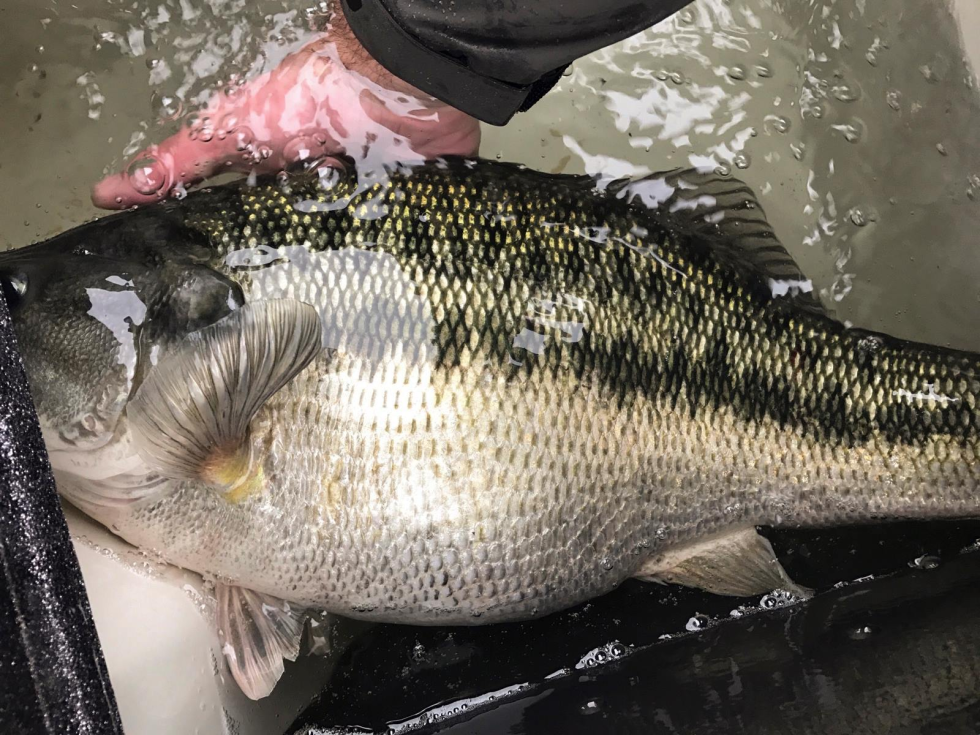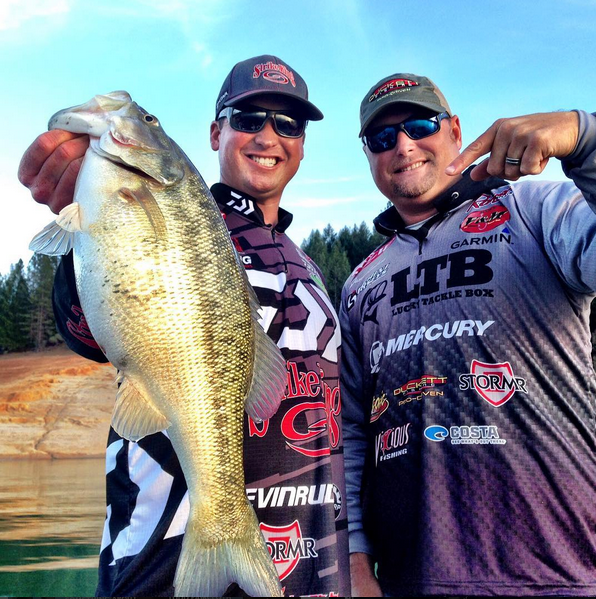
By Joel Shangle
Bass Nomad Media
AUBURN, Calif. – … and who, exactly, was surprised last week when Simms pro Cody Meyer yarded a potential-world-record 10.80-pound spotted bass out of the chilly waters of New Bullards Bar Reservoir in Northern California?
Nobody who’s paid any attention to Meyer’s wintertime antics the past several years, that’s for sure.
If you follow Meyer’s social-media channels, then you’re probably aware that December is as much about giant spotted bass for the Daiwa pro as it is about Christmas carols. Meyer – a consistent Angler of the Year threat on the FLW Tour – routinely treats Instagram and Facebook followers to a photo parade of oversized spots in the winter, from a variety of fisheries in Northern California.
A 5-pounder from Lake Shasta. Two 4-pounders from Whiskeytown Lake. And on and on.

For sheer numbers of trophy-sized spotted bass, Meyer’s Golden State fisheries are hard to beat – his pending world-record Spotzilla is just the most blatant example of how productive places like New Melones Reservoir, Whiskeytown, Bullards, etc. can be.
However, catching these fish in NorCal’s gin-clear, deep, cold water is far from simple.
Bass Nomad was fortunate to sit down with Meyer the week before he and buddy J.R. Wright racked up over 42 pounds on five spotted bass the day Meyer caught his record fish (42 pounds! For five fish!).
Here’s what Meyer had to say about the finer points of wintertime spot-hunting:
Bass Nomad: What is it about your NorCal fisheries this time of year? Are they all just loaded with big spots?
Meyer: We do have some great, deep reservoirs with a lot of spotted bass, but this time of year they’re just especially active. They’re typically gathered up around bait, and if you know how to find them, this is a great time of year to catch some big ones.
Bass Nomad: So then is it safe to assume that finding bait is your first priority in the winter?
Meyer: Absolutely. This time of year, I’m glued to my electronics. As soon as I start idling out of the marina, I’m staring at my electronics looking for bait– it’s scattered all over most of these lakes right now, so it’s not hard to find. Once I see bait in, say, 40 feet of water, I know that fish will most likely be at that depth, so I’ll run around and find structure that tops out in the 40-foot range.
That gives me a starting point. Fish will also suspend around thermoclines. They’ll get at the very end of a creek on these deep, clear lakes and suspend on temperature breaks there. You’ll see fish literally from the bank down to about 50 feet.
Bass Nomad: And how do you decipher what you’re seeing on your electronics? What are your keys?
Meyer: Because of the way they chase bait, you’ll frequently see a whole bunch of fish stacked in a ¼ to ½-mile section because that’s where the bait is … but you’ll also see everyone fishing right on top of each other in those areas. Guys will be all ganged up, throwing at the bank or dragging a worm on a point. But these big Northern California spots rarely go to the bottom: they live offshore where they can eat trout or kokanee.
The problem you have is that you can’t really cast a bait out into the middle of nothing, right? Garmin Panoptix is a HUGE advantage here. I can pull up to a point where everyone is dragging a worm, scroll around with my Panoptix, and see fish that you just wouldn’t know were there otherwise. I’ll fire a swimbait out there and watch fish come to the bait. Sometimes they come up and turn away, sometimes they follow the bait but don’t bite, but the bottom line is that you can see things with Panoptix that can clue you in better on what fish might want.

Bass Nomad: Expand on that a little. What do you mean by being “clued in” that way by your electronics?
Meyer: For example, say you’ve seeing fish down 10 to 20 fish. You throw a crankbait out there and fish start shooting up to it, but they only get so close to it before they turn away. They don’t want to come up that high. So what’s your adjustment? Well for one, you might try a deeper-diving crankbait. Or, maybe you’ll see fish race up to your bait and track it, but they won’t eat it. So you have to think about your color, or maybe your retrieve. Maybe they want a more natural color, or maybe they’ll respond better if you change the retrieve: Stop. Go. Stop. Go.
A jerkbait is a great example, too. You’ll frequently see fish come to a jerkbait pretty fast, but then they’ll just chase it a little and then lose interest. That means they probably want a different cadence: they want ‘jerk … pause, jerk, jerk … pause’. It’ll break your heart sometime because you’ll sometimes see hundreds of fish, and maybe two or three will want to eat your bait. But the thing with Panoptix is that you can see it unfold right in front of your eyes, and you can learn and adjust to the conditions as you go.
Bass Nomad: What are your two go-to presentations for spotted bass in the winter?
Meyer: I fish a drop-shot a lot: a ¼-ounce drop-shot weight and Strike King KVD Dream Shot in a natural-shad color. I like to cast it and let it pendulum-swing – it’s an easy, natural presentation that’s good for suspended, inactive fish. If I’m fishing on the bottom, I’ll go with a football-head jig with a Rage Craw or Strike King KVD Finesse Worm trailer.
You’d think these fish would be all over a swimbait, since a lot of their food is trout and kokanee salmon, but I haven’t really found that to be the case.
MEYER’S CRITICAL GEAR: Meyer’s setup for his 10.80-pound spotted bass: Daiwa Tatula rod; Daiwa Exist reel; 6-pound Seaguar Fluorocarbon Tatsu line; Strike King Ocho.
